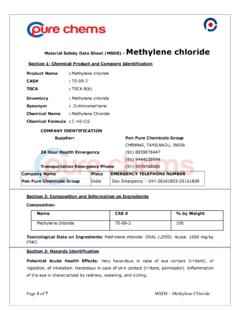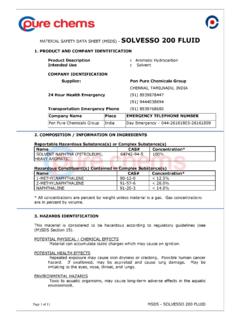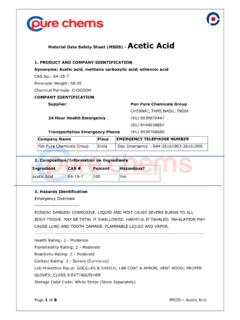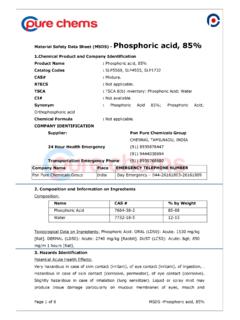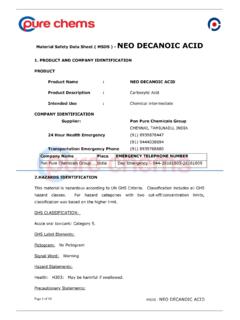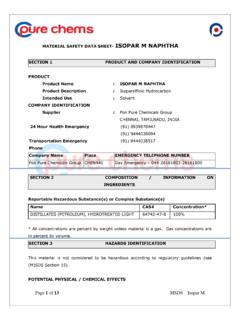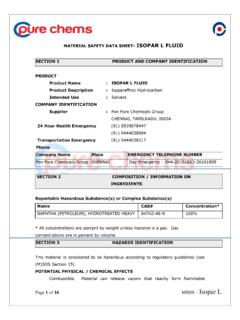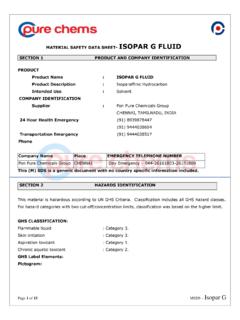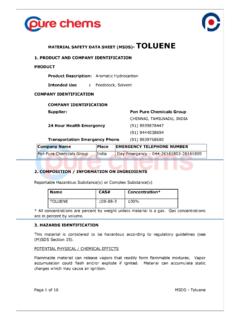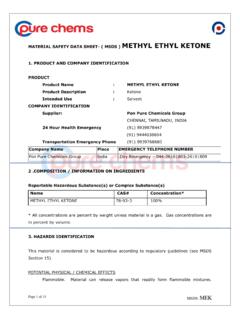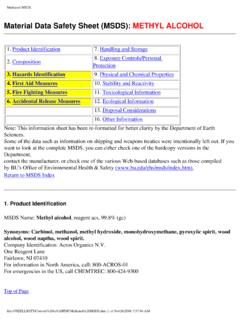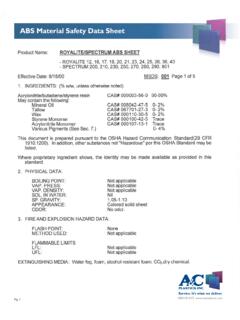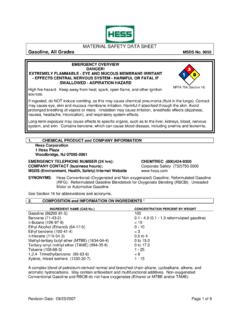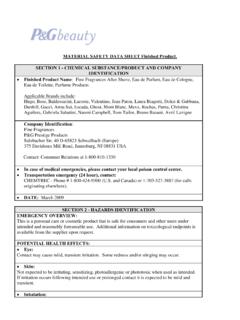Transcription of Material Safety Data Sheet (MSDS) - Dimethylformamide
1 msds - Dimethylformamide Page 1 of 9 Material Safety data Sheet ( msds ) - Dimethylformamide 1. Chemical Product and Company Identification Product Name : N,N- Dimethylformamide Catalog Codes : SLD4261, SLD3331 CAS# : 68-12-2 RTECS : LQ2100000 TSCA : TSCA 8(b) Inventory : N,N- Dimethylformamide CI# : Not applicable. Synonym : DMF; Dimethyl Formamide Chemical Name : N,N- Dimethylformamide Chemical Formula : HCON(CH3)2 COMPANY IDENTIFICATION Supplier: Pon Pure Chemicals Group CHENNAI, TAMILNADU, INDIA 24 Hour Health Emergency (91) 8939878447 (91) 9444038694 Transportation Emergency Phone (91) 8939768680 Company Name Place EMERGENCY TELEPHONE NUMBER Pon Pure Chemicals Group India Day Emergency 044-26161803-26161809 2: Composition and Information on Ingredients Composition: Name CAS # % by Weight {N,N-} Dimethylformamide 68-12-2 100 Toxicological data on Ingredients: N,N- Dimethylformamide : ORAL (LD50): Acute: 2800 mg/kg [Rat].
2 2900 mg/kg [Mouse]. 5000 mg/kg [Rabbit]. DERMAL (LD50): Acute: 4720 mg/kg [Rabbit]. 3. Hazards Identification Potential Acute Health Effects: Hazardous in case of skin contact (irritant, permeator), of eye contact (irritant), of ingestion, of inhalation. Potential Chronic Health Effects: msds - Dimethylformamide Page 2 of 9 CARCINOGENIC EFFECTS: 3 (Not classifiable for human.) by IARC. MUTAGENIC EFFECTS: Mutagenic for mammalian somatic cells. Mutagenic for bacteria and/or yeast. TERATOGENIC EFFECTS: Classified POSSIBLE for human. DEVELOPMENTAL TOXICITY: Classified Reproductive system/toxin/female, Reproductive system/toxin/male [POSSIBLE]. The substance is toxic to kidneys, liver, central nervous system (CNS). The substance may be toxic to blood, the nervous system. Repeated or prolonged exposure to the substance can produce target organs damage.
3 Aid Measures Eye Contact: Check for and remove any contact lenses. Immediately flush eyes with running water for at least 15 minutes, keeping eyelids open. Cold water may be used. Get medical attention. Skin Contact: In case of contact, immediately flush skin with plenty of water. Cover the irritated skin with an emollient. Remove contaminated clothing and shoes. Cold water may be clothing before reuse. Thoroughly clean shoes before reuse. Get medical attention. Serious Skin Contact: Wash with a disinfectant soap and cover the contaminated skin with an anti-bacterial cream. Seek immediate medical attention. Inhalation: If inhaled, remove to fresh air. If not breathing, give artificial respiration. If breathing is difficult, give oxygen. Get medical attention. Serious Inhalation: Evacuate the victim to a safe area as soon as possible.
4 Loosen tight clothing such as a collar, tie, belt or waistband. If breathing is difficult, administer oxygen. If the victim is not breathing, perform mouth-to-mouth resuscitation. WARNING: It may be hazardous to the person providing aid to give mouth-to-mouth resuscitation when the inhaled Material is toxic, infectious or corrosive. Seek medical attention. Ingestion: Do NOT induce vomiting unless directed to do so by medical personnel. Never give anything by mouth to an unconscious person. Loosen tight clothing such as a collar, tie, belt or waistband. Get medical attention if symptoms appear. Serious Ingestion: Not available. msds - Dimethylformamide Page 3 of 9 5: Fire and Explosion data Flammability of the Product : Flammable. Auto-Ignition Temperature : 445 C (833 F) Flash Points : CLOSED CUP: C (136 F). (Tagliabue.) : OPEN CUP: 67 C ( F). Flammable Limits : LOWER: UPPER: Products of Combustion : These products are carbon oxides (CO, CO2), nitrogen oxides (NO, ).
5 Fire Hazards in Presence of Various Substances: Flammable in presence of open flames and sparks, of heat. Non-flammable in presence of shocks. Explosion Hazards in Presence of Various Substances: Risks of explosion of the product in presence of mechanical impact: Not available. Risks of explosion of the product in presence of static discharge: Not available. Fire Fighting Media and Instructions: Flammable liquid, soluble or dispersed in water. SMALL FIRE: Use DRY chemical powder. LARGE FIRE: Use alcohol foam, water spray or fog. Cool containing vessels with water jet in order to prevent pressure build-up, autoignition or explosion. Special Remarks on Fire Hazards: Not available. Special Remarks on Explosion Hazards: A mixture of triethylaluminum and DMF explodes when heated. DMF + potassium permanganate may explode. 6. Accidental Release Measures Small Spill: Dilute with water and mop up, or absorb with an inert dry Material and place in an appropriate waste disposal container.
6 Large Spill: Flammable liquid. Keep away from heat. Keep away from sources of ignition. Stop leak if without risk. Absorb with DRY earth, sand or other non-combustible Material . Do not touch spilled Material . Prevent entry into sewers, basements or confined areas; dike if needed. Be careful that the product is not present at a concentration level above TLV. Check TLV on the msds and with local authorities. msds - Dimethylformamide Page 4 of 9 7. Handling and Storage Precautions: Keep locked up. Keep away from heat. Keep away from sources of ignition. Ground all equipment containing Material . Do not ingest. Do not breathe gas/fumes/ vapor/spray. Wear suitable protective clothing. In case of insufficient ventilation, wear suitable respiratory equipment. If ingested, seek medical advice immediately and show the container or the label. Avoid contact with skin and eyes.
7 Keep away from incompatibles such as oxidizing agents, acids. Storage: Store in a segregated and approved area. Keep container in a cool, well-ventilated area. Keep container tightly closed and sealed until ready for use. Avoid all possible sources of ignition (spark or flame). 8. Exposure Controls/Personal Protection Engineering Controls: Provide exhaust ventilation or other engineering controls to keep the airborne concentrations of vapors below their respective threshold limit value. Ensure that eyewash stations and Safety showers are proximal to the work-station location. Personal Protection: Splash goggles. Lab coat. Vapor respirator. Be sure to use an approved/certified respirator or equivalent. Gloves. Personal Protection in Case of a Large Spill: Splash goggles. Full suit. Vapor respirator. Boots. Gloves. A self contained breathing apparatus should be used to avoid inhalation of the product.
8 Suggested protective clothing might not be sufficient; consult a specialist BEFORE handling this product. Exposure Limits: TWA: 10 (ppm) from ACGIH (TLV) [United States] TWA: 30 (mg/m3) from ACGIH (TLV) [United States] Consult local authorities for acceptable exposure limits. and Chemical Properties Physical state and appearance : Liquid. Odor : Amine like. (Slight.) Taste : Not available. Molecular Weight : g/mole Color :Colorless to light yellow. pH (1% soln/water) : Not available. Boiling Point : 153 C ( F) msds - Dimethylformamide Page 5 of 9 Melting Point : -61 C ( F) Critical Temperature : 374 C ( F) Specific Gravity : (Water = 1) Vapor Pressure : kPa (@ 20 C) Vapor Density : (Air = 1) Volatility : Not available. Odor Threshold : 100 ppm Water/Oil Dist. Coeff. : The product is more soluble in water; log(oil/water) = -1 Ionicity (in Water) : Not available.
9 Dispersion Properties : See solubility in water, diethyl ether, acetone. Solubility : Easily soluble in cold water, hot water. Soluble in diethyl ether, acetone. Miscible organic solvents. Soluble in benzene, and chloroform. 10: Stability and Reactivity data Stability: The product is stable. Instability Temperature: Not available. Conditions of Instability: Heat, ignition sources (sparks, flames), incompatible materials Incompatibility with various substances: Reactive with oxidizing agents, acids. Corrosivity: Non-corrosive in presence of glass. Special Remarks on Reactivity: Can react vigorously with oxidizing agents, halogenated hydrocarbons, and inorganic nitrates. Incompatible with carbon tetrachloride, alkyl aluminums, sodium tetrahydroborate, nitrates, chromic acid, diisocyanatomethane, triethylaluminum, sodium hydride, lithium azide, metallic sodium, bromine, magnesium nitrate, potassium permanganate, nitric acid, chromium trioxide, borohydrides, phosphorus trioxide, diborane, octafluoroisobutyrate, sodium nitrite, perchloryl fluoride, postassium methyl 4,4'-dinitrobutyrate.
10 Reaction with inorganic acid chlorides, such as phosphorous oxychloride and thionyl chloride, may form dimethylcarbamoyl, a suspect carcinogen. May release dimethylamine and carbon monoixde if heated above 350 C (662 F). Special Remarks on Corrosivity: Pure Dimethylformamide is essentially non-corrosive to metals. However copper, tin and their alloys should be avoided. Polymerization: Will not occur. msds - Dimethylformamide Page 6 of 9 Information Routes of Entry: Absorbed through skin. Dermal contact. Eye contact. Inhalation. Ingestion. Toxicity to Animals: WARNING: THE LC50 VALUES HEREUNDER ARE ESTIMATED ON THE BASIS OF A 4-HOUR EXPOSURE. Acute oral toxicity (LD50): 2800 mg/kg [Rat]. Acute dermal toxicity (LD50): 4720 mg/kg [Rabbit]. Acute toxicity of the vapor (LC50): 9400 1 hours [Mouse]. Chronic Effects on Humans: CARCINOGENIC EFFECTS: 3 (Not classifiable for human.)
